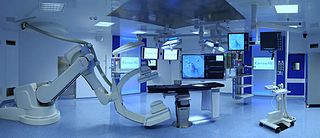Application
Patient registration was used mostly in head surgery – oral and maxillofacial surgery, neurosurgery, otolaryngology. With the advent of marker- and markerless-registration, the concept has been extended for abdominal surgery.
Using headframes
The first attempts in 3D mapping of human tissues were made by V. Horsley and R. Clarke in 1906. [1] They have built a rectangular stereotactic headframe that had to be fixed to the head. It was based on cartesian principles and allowed them to accurately and reproductibly guide needle-like electrodes for neurophysiological experiments. They have experimented animals and were able to contribute to the mapping of the cerebellum. Improved versions of the Horsley–Clarke apparatus are still in used today in experimental neurosurgery.[ citation needed ]
The first stereotactic device for humans was also developed in neurosurgery, by E. Spiegel and H. Wycis in 1947. [2] It was used for surgical treatment of Parkinson's disease and, during time, its applicability was extended for the surgical treatment of tumors, vascular malformations, functional neurosurgery etc. The system was based both on headframes and X-ray images taken for all three planes of space.
Further development of stereotactic surgery was made by Brown, Roberts and Wells in 1980. [3] They have developed a halo ring that was applied on the skull, during a CT scan and neurosurgical interventions. This method provided improved surgical guidance and was in fact the first development of computer guided surgery.
Patient registration for the head area has developed for nearly two decades on the same principle of combining CT scans with mechanical reference devices such as headframes or halo rings. But the clinical experience showed that headgear is very uncomfortable to wear and even impossible to apply on little children, because their lack of cooperation; furthermore, the headframes can create artifacts in preoperative data gathering, or during surgery.[ citation needed ]
Reference markers
Skin
In 1986, a different approach was developed by Roberts und Strohbehn. [4] They have used as landmarks several markers on the patient's skin both preoperative CT registration, and intraoperatively. This was a new current of the time in patient registration. Still, the method is time-consuming, and the exact reproducitibility of the marker positions is questionable.
Bone
The bony structures can provide a much better stability and reproducibility of the landmarks for patient registration. Based on this concept, a further technique was used: to implant temporary markers into bone structures that are superficial to the skin, under local anestesia. [5] This was also combined with surface markers and CT registration. [6] The technique has the disadvantage of a further minimal surgical procedure of placing the bone implants, with some risk of infection for the patient.

Dental splint markers
Dental splints have been traditionally used for transferring and reproducing 3D reference landmarks for positioning cast models in articulators – in dental prosthetics, orthodontics and orthognathic surgery. By applying several infrared markers on the splints and using an infrared camera, a better registration was obtained. [7]
Markerless patient registration
Anatomical landmarks
The first attempts, based on the identification of anatomical landmarks were made by Caversaccio and Zulliger. [8] The method was based on identifying certain antropometrical points and other anatomical landmarks on the skull, in correlation with the CT registration. But the landmarks cannot be exactly pointed out and reproduced during patient dataset registration and surgery, therefore the method is not precise enough.
Surface registration


Since 1998, new procedures have been developed by Marmulla and co-workers, using a different approach to the problem. [9] [10] Both during CT dataset gathering and surgical intervention, the patient registration was made by registering complete areas and surfaces, instead of distinctive surface markers. This was achieved by using laser scanners and a small guiding transmitter. The precision of the patient registration was significantly improved with this method.
Based on this concept, several registration and navigation systems were built by the same team. The Surgical Segment Navigator (SSN and SSN++) is such a system, developed for the first time for oral and maxillofacial surgery. This system correlates three different coordinate sets: CT data set, surface laser scan data set and the dataset produced by a small guiding transmitter, placed on the patient's head. The Laboratory Unit for Computer-Assisted Surgery (LUCAS) is used for planning surgery in the laboratory. This technological and surgical advance has permitted the elimination of mechanical guidance systems and improved the accuracy of the determinations, and thus the surgical act.
A research group at Ryerson University (now Toronto Metropolitan University) developed a method to use optical topographical imaging (OTI) to create a 3D model of the surface of open surgical sites and perform surface registration to CT and MRI data sets for neurosurgical navigation. [11] [12] The OTI technology is being licensed by 7D Surgical for their navigation platform. [12]










